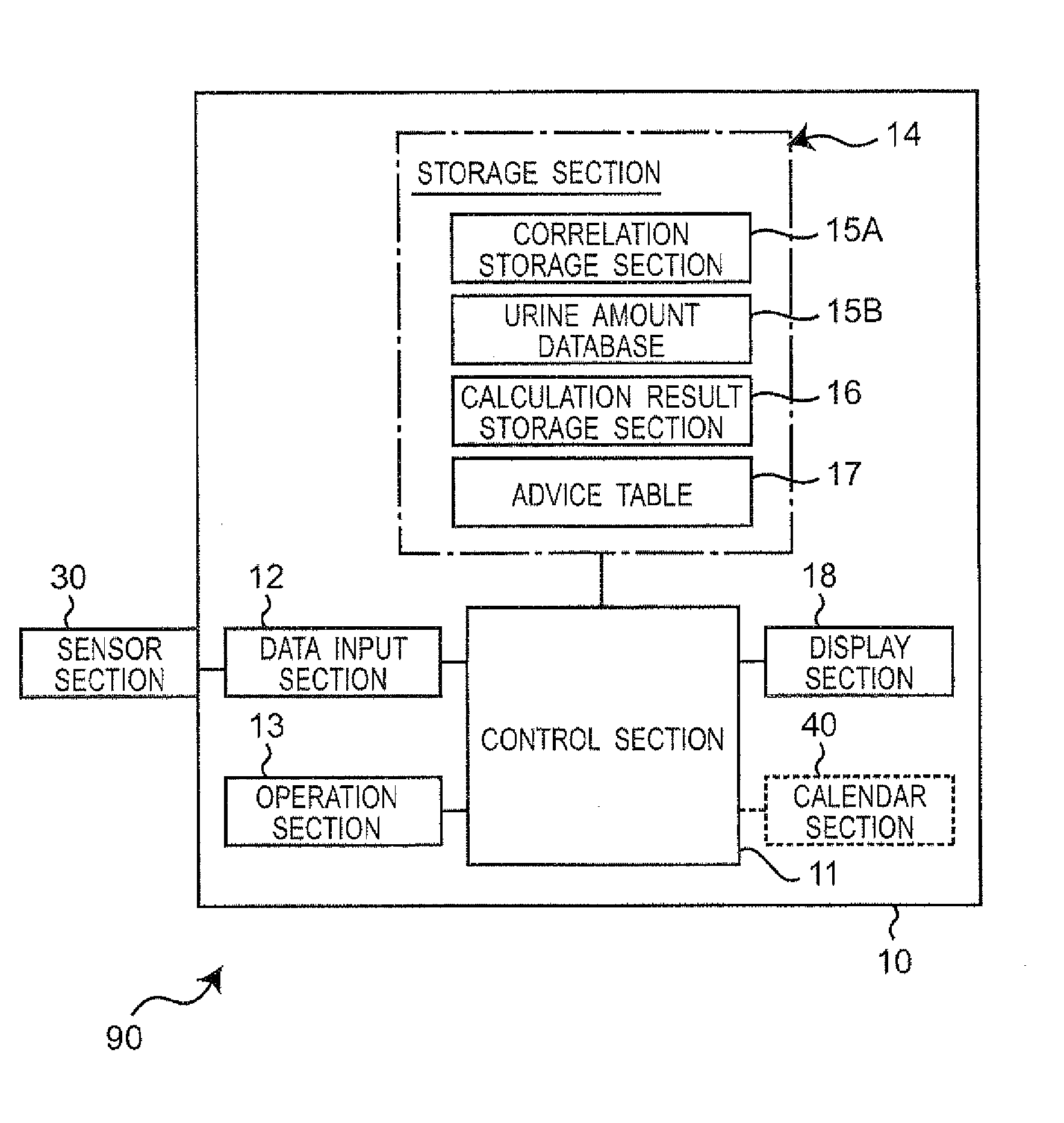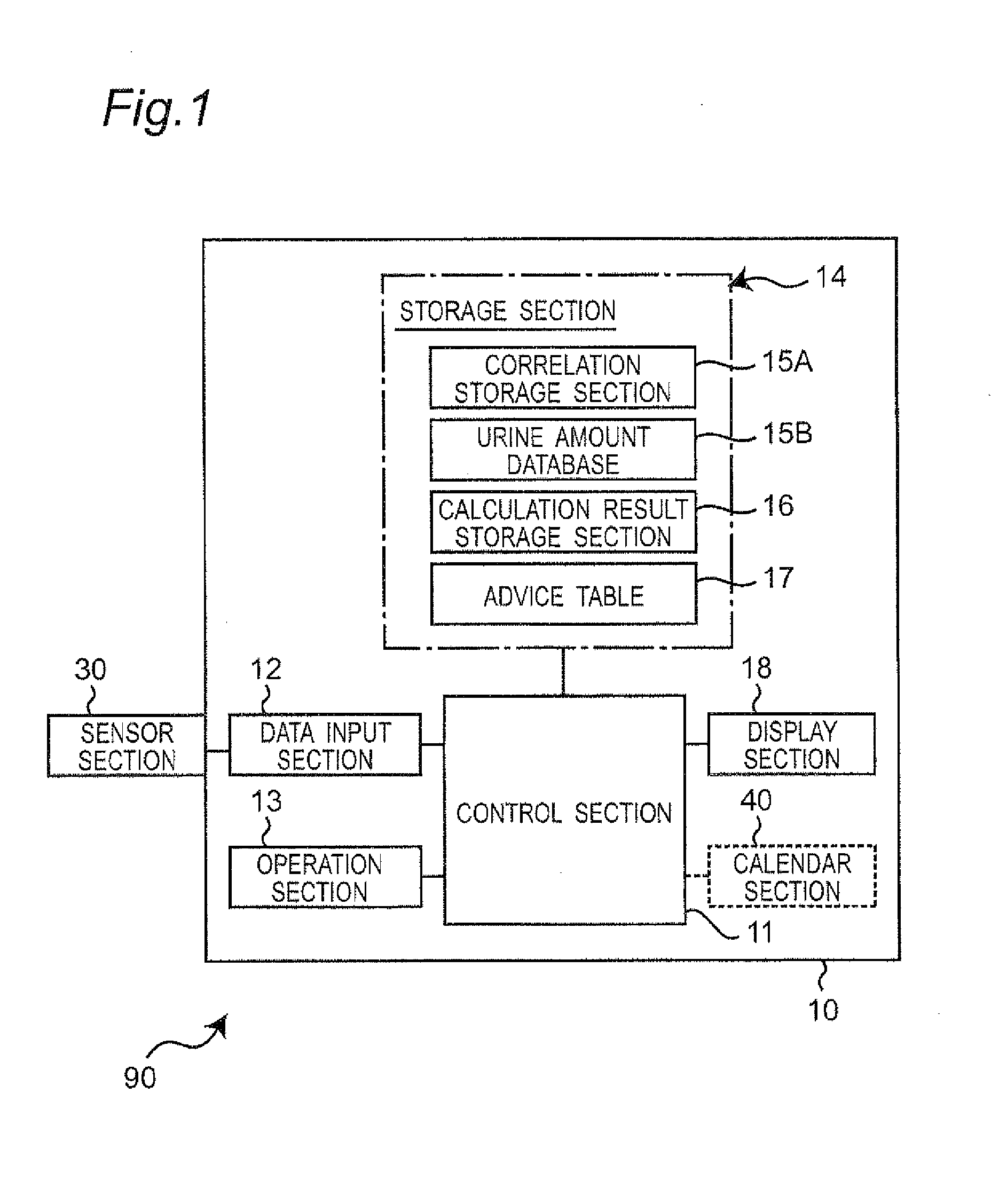Urine component analysis device and urine component analysis method
- Summary
- Abstract
- Description
- Claims
- Application Information
AI Technical Summary
Benefits of technology
Problems solved by technology
Method used
Image
Examples
first embodiment
[0047]FIG. 1 shows a block configuration of a urine component analysis device (denoted by symbol 90 as a whole) of one embodiment of the present invention.
[0048]The urine component analysis device 90 includes a housing 10, a control section 11 mounted and stored in the housing 10, a data input section 12, an operation section 13, a storage section 14 and a display section 18 as a notification section. Further, the urine component analysis device 90 includes a sensor section 30 attached to the housing 10 so as to be projected to outside from the housing 10.
[0049]In this example, the housing 10 has a narrow and long prism-like external shape so that the housing is held by the user's hand as shown in FIG. 2A. The sensor section 30 is attached at one end of the housing 10 and has a narrow and long rod-like external shape. As a result, the urine component analysis device 90 is formed as a hand-held type urine component analysis device that is used by a user with the housing 10 held in th...
second embodiment
[0108]In the first embodiment described above, a NaCl concentration in total urine in one day is determined by performing conversion based on a NaCl concentration in one urine excreted by a subject, but the present invention is not limited thereto. A Na concentration (or NaCl concentration) in total urine in one day may be each determined by performing conversion based on a Na concentration (or Ned concentration) in plural urines (two urines in this example) excreted by the subject over plural days.
[0109]In this case, as shown in, for example, FIG. 13A, data indicating a correlation between an average Na concentration obtained using two urines (first and second urines after wake-up) and a measured Na concentration in total urine in one day is stored in a correlation storage section 15. Specifically, FIG. 13A shows a case where a relationship between an average Na concentration obtained by averaging the measured Na concentration in the first urine after wake-up and a measured Na conc...
third embodiment
[0138]In the embodiments described above, an excretion amount of Na (or NaCl) in total urine in one day is determined by conversion, but an average value per day of the excretion amount of Na (or NaCl) may be determined based on a excretion amount of Na (or NaCl) obtained for each day.
[0139]Specifically, a control section 11 acts as a second calculation section to read a daily excretion amount of Na (or NaCl) stored in a calculation result storage section 16 and calculate an average value per day.
[0140]FIGS. 15A and 15B and FIGS. 16A and 16B each show a result of examining an average value per day of the Na excretion amount obtained for each day, by using an average value per day of the measured Na excretion amount in total urine, while variously changing a period (number of days) d for which the average value is calculated.
[0141]Specifically, FIG. 15A shows a result of examining a Na excretion amount in total urine in one day (d=1), which is obtained by conversion using one urine (...
PUM
 Login to View More
Login to View More Abstract
Description
Claims
Application Information
 Login to View More
Login to View More - R&D
- Intellectual Property
- Life Sciences
- Materials
- Tech Scout
- Unparalleled Data Quality
- Higher Quality Content
- 60% Fewer Hallucinations
Browse by: Latest US Patents, China's latest patents, Technical Efficacy Thesaurus, Application Domain, Technology Topic, Popular Technical Reports.
© 2025 PatSnap. All rights reserved.Legal|Privacy policy|Modern Slavery Act Transparency Statement|Sitemap|About US| Contact US: help@patsnap.com



